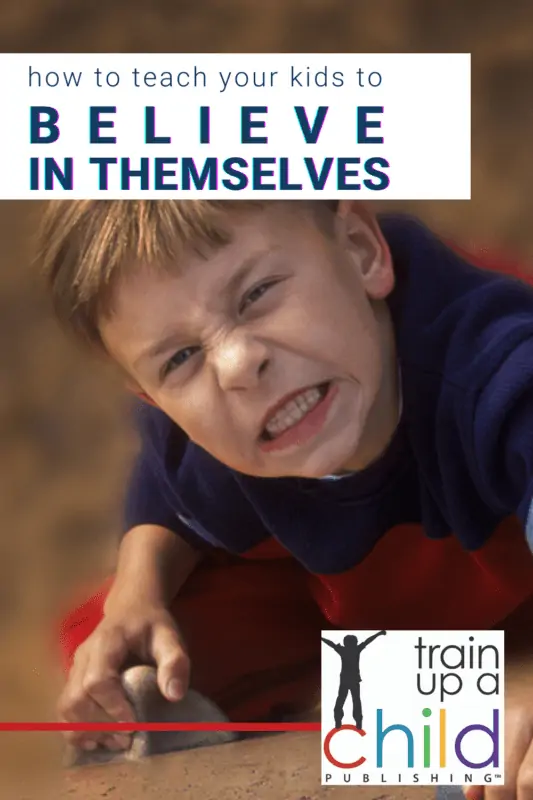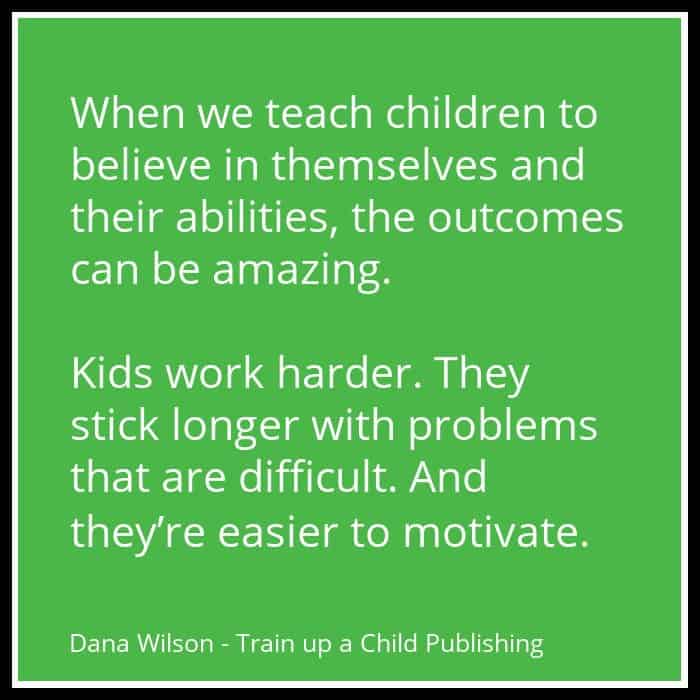How to teach your children to believe in themselves

Why does one child stare at the ceiling and sigh, while another takes a deep breath, focuses on what he has to do, and digs into his work?
The difference is this: the first child doesn’t believe he can do the work. In contrast, the second one believes he can. How did he come to believe that? Because you, his teacher, continually teach him to believe in himself by the way you talk to him.
You believe in him=he believes in himself.
The first child might think his work is too hard. He may think he’s not smart enough to figure it out. So he stares at the ceiling, wishing he wasn’t so dumb. Wishing his work wasn’t so hard.
In contrast, the second child may think his work is hard, too…. but he has HOPE. He’s not afraid to try. And he’s willing to struggle for a while, knowing that it will take effort, but believing he’ll eventually figure it out. (Or find someone who can help him figure it out.)
Let’s boil down the difference between the two children a little further.
The difference is in their core beliefs about themselves. The first child doesn’t believe he can do the work. He’s defeated before he starts.
Alternatively, the second child believes in himself. He has self-confidence. Therefore, he has more emotional resilience. He’s not afraid to tackle something hard. He has a more optimistic view of his ability to master a hard thing if he puts enough work into it.
So was the second child just born like that? How did he learn to be more self-confident? Sometimes it’s a mystery, right? But thankfully, you can teach your children to believe in themselves. You can help build your child’s confidence in how you talk to him. In how you encourage him. Keep reading to learn how!
- Why does one child stare at the ceiling and sigh, while another takes a deep breath, focuses on what he has to do, and digs into his work?
- The difference is this: the first child doesn't believe he can do the work. In contrast, the second one believes he can. How did he come to believe that? Because you, his teacher, continually teach him to believe in himself by the way you talk to him.
- You believe in him=he believes in himself.
- Let's boil down the difference between the two children a little further.
- First, what's the benefit of children learning to believe in themselves?
- And if we want to bring our kids' homeschool education to life and have a happy, thriving home, it's important that we teach our kids to believe in themselves so they'll work harder, be easier to teach, not give up, master their lessons, and work more independently.
- Teaching your kids to believe in themselves starts by learning to be more optimistic.
- The first step to teaching your children to believe in themselves is to do it in a non-stressful, peaceful environment.
- Before you can teach your children to believe in themselves, they must believe that YOU believe in them.
- 7 Steps to teach your children to believe in themselves and their abilities.
- 1. Show your kids that you believe in them, as I've been saying.
- 2. Help your kids to build on their successes.
- 3. Compare your student's current achievement with his past ones — not with his older brother's or someone else's.
- 4. Tie your praise into the effort that you see your child put into something.
- 5. Give clear, detailed, and honest (but kind) feedback, focusing on the facts instead of making vague, emotional comments.
- 6. Teach your children to believe in themselves and their ability — that success isn't something they are born with or born without.
- 7. There are no failures, just lessons.
- In many cases, you have to bring them from a pessimistic view/fixed mindset that they aren't capable of learning something… to the positive, optimistic, growth mindset that THEY CAN learn.
- If you want your kids to work harder, be more motivated, and achieve more academic (and every other kind of) success, teach them how to believe in themselves.

Editor’s Note: This post includes affiliate links to items we use and love. If you purchase any of these things, we might make a small commission at no extra cost to you. (But I appreciate your support so much — thank you!)
First, what’s the benefit of children learning to believe in themselves?
- Children who believe in themselves can learn more.
- They’ll work harder.
- They’re willing to struggle longer with a difficult problem.
- Kids who believe in themselves are easier to motivate.
- They gain more and more self-confidence as they accomplish more and more.
Which child do you think would be easier to teach? Which one would learn more quickly and thoroughly? And work more independently?
You’re right!
The one who believes in himself and his abilities will take less time and energy to teach.
And if we want to bring our kids’ homeschool education to life and have a happy, thriving home, it’s important that we teach our kids to believe in themselves so they’ll work harder, be easier to teach, not give up, master their lessons, and work more independently.
Moreover, not only does it help you homeschool more effectively to teach your kids self-confidence. Developing this trait will last them into college and beyond! It’s truly the gift that keeps on giving.
And believe it or not, optimism, thinking positively, looking for the best in things, a growth mindset, whatever you want to call it… is usually not something you were born with. But it’s something you can learn.
If you struggle with this yourself, I’d recommend this book. It’s not a “woo” thing; it’s a science thing, although it took me awhile to believe that when I first heard about it.
Also, read about how to improve your thinking to improve your homeschooling.
Developing an optimistic viewpoint (also called a growth mindset) is your kids’ bridge to belief in themselves.
So even if you (or your kids) are self-proclaimed pessimists, you can LEARN to be more optimistic. I’ve seen it firsthand in my own family and in others. If thinking optimistically is new to you, it will take some work.
You’ll need to pay attention to what you are “saying to yourself” and practice catching yourself thinking negative thoughts.
Then choosing to stop thinking that negative thought and substitute a more positive thought in its place. It definitely takes some work and practice thinking differently than you did before. And then you’ll have to teach your kids to do it. But it’s so worth it!
Teaching your kids to believe in themselves starts by learning to be more optimistic.
Research (sources below) has shown that being more positive yields great benefits for those practicing it. In general, it makes people:
- happier and more satisfied
- healthier
- believe that they can influence their circumstances instead of having no control over them
- be less fearful about trying new things and making mistakes
- do better in school

Therefore, if your children learn to believe in themselves NOW, while they’re in your home and homeschooling… you’ll have given them a priceless boost. You will have taught them to work hard and not be afraid to try new and hard things–and that kind of effort is a huge factor in success.
The first step to teaching your children to believe in themselves is to do it in a non-stressful, peaceful environment.
Constant stress and learning don’t go together. So when kids live in a stressful daily environment, learning just doesn’t stick.
But what if you’re homeschooling as a single mom, trying to educate your children with an unfriendly-to-homeschooling spouse, or have a child with a learning disability?
Even though you have challenges that others might not have to face, as much as you can, make school an oasis for your kids. Try and create a routine. Be as organized as you can. If you have a plan and a routine, your kids will have more confidence in your ability to teach them. If you need to simplify your homeschool life to make that happen, then work on that a little at a time.
Also, emphasize that everyone speaks kindly and respectfully to you and to each other. Even if you have to close the math books to work through a sibling squabble, having a peaceful (for the most part) homeschool is worth it.
I say “for the most part” because we all know it can’t be like that 100% of the time.
The idea is not to do it perfectly but to do it as well as you can in the areas that matter the most.
Again, homeschooling in a peaceful environment gives your kids the right foundation to learn and grow.
Before you can teach your children to believe in themselves, they must believe that YOU believe in them.
Read that again!
Before you can teach your children to believe in themselves, they must believe that YOU believe in them.
There are many Bible verses that show how important it is that we speak to one another carefully. Thoughtfully. Graciously. Kindly. Sometimes we think this kind of speech applies to our husbands or friends but not our kids.
Our children also need to be treated with and spoken to with respect. And if you weren’t raised like that by your parents, it’s something you’ll have to learn how to do for your children.
If you’ve made mistakes in this area, join the club! I still cringe remembering something I said to one of my kids several years ago. I wasn’t angry or trying to be mean. It was just a thoughtless comment that wasn’t kind. It still makes me feel bad. If you struggle with this sometimes, as I do, that means you’re human. Just sincerely apologize and move on.
Every mother on the planet can look back and see things she wishes she’d done better. Learn now how to express yourself in a way that builds children up. (You’ll see examples soon~keep reading.)
Speaking kindly and in a way that helps you show your belief in your kids may take some work on your part. Again, it may involve learning to reframe some of your negative thoughts into more positive thoughts. As a result, those more positive thoughts will lead to more positive and encouraging statements from you.
You can do this!
Disclaimer: please don’t think I’m saying it’s your fault if your child struggles with self-confidence! Some children do much more than others. Keep reading for several additional ideas on how to help your child who struggles with self-confidence and resilience in this post.
Read this example of an “I believe in you!” speech.
Your daughter has botched a math test. You don’t think she worked hard enough, so your temptation is to give her an earful about what you think of this latest bad test score.
Consequently, what you’re thinking might be, She’s lazy. She doesn’t do her work. I wish she were better at math, like her brother.
But instead of letting those thoughts have free reign in your head and pushing you to say something unkind or discouraging, simply tell yourself:
She doesn’t understand math….YET. She hasn’t learned to work as diligently as she should….YET. She can do it… she just hasn’t done it YET.
And then, that new thinking helps you sincerely say:
Annie, I see that your math test score was lower than I think you’re capable of. Let’s plan to work on the test problems together and then retest. You don’t understand this YET, but you’ll get there with a little more targeted diligent work.
Speaking positively in this way gives Annie HOPE that she can learn to achieve more in math.
And just as important, it underscores that YOU think she can do better in math.
So far you’ve read about:
- the value of your children being more positive and optimistic about their abilities.
- the importance of having a positive and non-stressful environment in your homeschool
- how important it is to believe in and speak encouragingly to your kids
So besides all that, what else does it take for students to believe in themselves, and what can you do to teach them how?
7 Steps to teach your children to believe in themselves and their abilities.
Research shows that these seven tips help children believe in themselves.
1. Show your kids that you believe in them, as I’ve been saying.
Tell them you’re on their side. That you’re in this homeschooling thing together. And that you’ll do whatever it takes to help them succeed. Think of yourself as a coach or a mentor coming alongside them, especially as they get older.
I’m not saying be their “buddy.” Kids need parents to be parents, not parents trying to be BFFs.
2. Help your kids to build on their successes.
Help them have a string of past successes they can look back on before tackling something harder. It’s better to give your kids incrementally more difficult tasks they can succeed with rather than blowing them out of the water with something that’s a huge jump in difficulty.
I’m not saying you shouldn’t challenge your kids. Instead, don’t let there be a huge gap from what a child is used to until he’s ready for it.
Example:
If your high school student is just learning to write essays, don’t hit her with a 25-page research paper. Her first research paper should be more like 5-7 pages. And let her choose a topic she’s interested in. That way she can concentrate on learning the research paper format before tackling that lengthy research paper on a less familiar topic.
3. Compare your student’s current achievement with his past ones — not with his older brother’s or someone else’s.
Example of not comparing:
Say:
You did much better on this math test than on your last one! Great job!
Don’t say:
You did better on this math test, but I wish you’d done as well as your sister did on hers.
4. Tie your praise into the effort that you see your child put into something.
Example of praising for the effort more than the outcome:
Say:
I’ve watched you work hard on getting your letters right. With that kind of effort, they’ll get better and better. Good job.
—or—
I love how you have been working a little longer on your math lesson these last few days. That extra time you’re spending is going to pay off!
5. Give clear, detailed, and honest (but kind) feedback, focusing on the facts instead of making vague, emotional comments.
Example of giving specific feedback on an assignment:
Say:
Your short story has an interesting premise. It would be even more interesting if you had the main character go through some smaller struggles leading up to the story’s main conflict.
Don’t say:
Your short story is a little dull. I don’t know where this story is going. You need to add more.
6. Teach your children to believe in themselves and their ability — that success isn’t something they are born with or born without.
In fact, success is earned with effort. So help your children connect the dots between hard work and success. This gives them hope that if they work harder, they’ll do better.
Example of praise that is specific and focused on the effort your child put forth:
Say:
Your lab reports are improving as you’ve paid more attention to recording your findings and clearly explaining your results. I can see the effort you’re putting into this!
Don’t say:
You’re a natural-born scientist! You always ace science.
(OR, If the lab reports need work, make sure you tell your student WHY they needs work. Be specific so your child knows exactly what needs to be improved.)
So can you see why praising effort rather than natural ability is so important?
If your student grows up thinking he’s “all that” in a subject and then goes to college without learning to work hard, he’s liable to freeze up when his work gets hard. And it will!
In high school or college, your student will probably come up against something much more difficult than he’s encountered before. Let’s say that this happens in a subject he thought he had “natural talent.”
At the least, he will have a bubble burst and might want to give up instead of knowing how to push through it.
7. There are no failures, just lessons.
Teach your children that it is OKAY to make mistakes. I love the acronym F.A.I.L. It stands for First Attempt In Learning.
Especially if you have a sensitive child, you will have to really hammer this truth home.
Just think about it. If “failure” is just a “lesson” instead of a “moral weakness” or a “lack of ability”… Doesn’t that make it easier to try hard or new things?
Consequently, if fear of failure is taken off the table, there are no limits to what your children might accomplish! (Or you, for that matter.) Besides, you can tell your kids that it is the STRUGGLE to learn something that helps their brain grow! (And brain research backs that up!)
So the fact about success is that it takes work. Practice. Struggle. Perseverance. But to get your kids to do those things, you must teach them to believe in themselves.
In many cases, you have to bring them from a pessimistic view/fixed mindset that they aren’t capable of learning something… to the positive, optimistic, growth mindset that THEY CAN learn.
Then they’ll be able to rise to the challenges you give them and that they’ll encounter later in life. They’ll know that working hard is what will take them to the heights they want to reach.
If you want your kids to work harder, be more motivated, and achieve more academic (and every other kind of) success, teach them how to believe in themselves.
It’s a lesson that will pay a lifetime of dividends!
With hope and grace,

Editor’s Note: This post includes affiliate links to items we use and love. If you purchase any of these things, we might make a small commission at no extra cost to you. (But I appreciate your support so much — thank you!)
Resources and Sources:
Brain-based Teaching Tips for Your Homeschool
Improve your homeschooling by Improving your thinking
Big Life Journal – teaching your kids grit and resilience
Mindset, by Carol Dweck
Fiona Parashar, The Psychology of Optimism and Pessimism: Theories and Research Findings, Positive Psychology.org.uk, October 24, 2009
Academic Optimism of Schools: A Force for Student Achievement, American Educational Research Journal, Fall 2006, Vol. 43, No. 3, pp. 425–446.
Maggie Wray, Ph.D., Why by Students Earn Better Grades, Creating Positive Futures, October 12, 2015.
Optimism and your Health, Harvard Health Publishing, Harvard Medical School, May 2008.
The development of optimism and perceived attainment from elementary school to junior high school by Reizo Koizumi, Japanese Psychological Research, 1999, Vol. 41, Number 4, pp. 206-214.
Nancy Barile, M.A.Ed., The Truth About the Effect of Teacher Optimism on Student Performance, Hey Teach!, Western Governors University, accessed May 19, 2019.
Nancy Barile, M.A.Ed., Teacher Comments are Powerful, Hey Teach!, Western Governors University, accessed May 19, 2019.
Educational Psychology. Authored by: Kelvin Seifert and Rosemary Sutton. Located at: https://open.umn.edu/opentextbooks/BookDetail.aspx?bookId=153. License: CC BY: Attribution
Elizabeth Scott, M.S., The Many Benefits of Optimism, verywellmind, Dotdash Publishing, accessed May 20, 2019
“The Power of Belief” Ted talk






I love this post! I have a soon to be 9 year old daughter that really struggles with believing in herself. I am definitely going to use these with her. Now to remember to use the word “yet”.
Thank you, Heidi! I’m sure it’s encouraging to have some strategies you can use to help build your daughter’s confidence. “Yet” just gives everyone so much hope! Thanks for commenting.
I love all your concrete examples! This is an awesome resource – thank you for sharing! And we’re big on the power of yet over here too…such a powerful lesson.
Hi Molly, thank you for your kind words; you’re very welcome! Isn’t “yet” a game changer?!